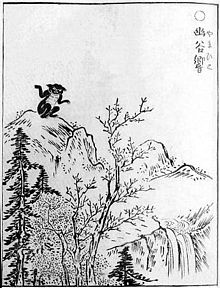


Yamabiko (山彦, also yamahiko) is a mountain god, spirit, and yōkai in Japanese folklore; the term "yamabiko" also refers to the echo that occurs in mountains, after which the yōkai is named. Literally translated, the term means "mountain boy". It is the yōkai responsible for the natural phenomenon in mountains or canyons. Living deep in the mountains, direct encounters with the yamabiko are rare. Often they are heard, but never seen. The small and elusive yokai wasn't officially classified until the Edo period in Japan. Instead the bizarre noises coming from the mountain were attributed to a natural phenomenon, like birds, and not given any spiritual significance. It is usually depicted with gray fur, peach-colored belly, floppy ears, large grin, and arms outstretched as though it is caught mid-shrug.
Mythology
The yamabiko is a small creature that resembles a cross between a dog and a monkey.
The term "yamabiko" is also used to describe the phenomenon of a delayed echo in mountains and valleys, and is thought to be the spirit answering. In this case, it is written as 幽谷響. This anomaly is also sometimes called "kodama", when it is thought to be the answering voice of a tree spirit (木霊 or 木魂).
Legends by area
In Tottori, Tottori Prefecture, a yobuko (呼子, "calling child") or a yobukodori (呼子鳥, "small calling bird") that lives in the mountain is thought to give out the yamabiko's voice. In Kusuyama of Hashikami village, Hata District, Kōchi Prefecture (now Sukumo), regardless of whether it was day or night, when a sudden dreadful voice is heard deep in the mountains, this strange phenomenon is called "yamahiko".
They are sometimes seen to be the same as the yamawaro, spoken of in Western Japan, as well as the yamako in the Wakan Sansai Zue, and as it is thought that tree spirits would cause yamabiko to occur, they are also seen to be the same as the yōkai penghou that lives in trees. In collections of yōkai depictions like the Hyakkai Zukan and the Gazu Hyakki Yagyō, the yamabiko that looks like a dog is thought to be based on the yamako or the penghou.
The aforementioned yobukodori of Tottori is said to take on the appearance of a bird, and other than that, there is also a small rock mountain in Kitaazumi District, Nagano Prefecture called the "yamabiko rock" (山彦岩) that return people's words, among other appearances of the word "yamabiko", and thus it can be seen that the yamabiko as yōkai are not uniform in either origin or what kind of yōkai they are.
See also
References
- Foster, Michael Dylan (2015-01-14). The book of yōkai : mysterious creatures of Japanese folklore. Berkeley. ISBN 9780520959125. OCLC 893735854.
{{cite book}}: CS1 maint: location missing publisher (link) - ^ Toriyama, Sekien; 鳥山石燕 (2017-01-18). Japandemonium illustrated : the yokai encyclopedias of Toriyama Sekien. Yoda, Hiroko,, Alt, Matt,, 依田寬子. Mineola, New York. ISBN 978-0486800356. OCLC 909082541.
{{cite book}}: CS1 maint: location missing publisher (link) - Komatsu, Kazuhiko; 小松和彦 (2017-03-27). An introduction to Yōkai culture : monsters, ghosts, and outsiders in Japanese history. Yoda, Hiroko,, Alt, Matt,, 依田寬子 (First ed.). Chiyoda-ku, Tokyo. ISBN 9784916055804. OCLC 981912840.
{{cite book}}: CS1 maint: location missing publisher (link) - 村上健司 編著 (2000). 妖怪事典. 毎日新聞社. pp. 352頁. ISBN 978-4-620-31428-0.
- 柳田國男 (1977). 妖怪談義. 講談社学術文庫. 講談社. pp. 201頁. ISBN 978-4-06-158135-7.
- 桂井和雄 (June 1942). "土佐の山村の「妖物と怪異」". 旅と伝説. 15巻 (6号(通巻174号)): 23頁.
- ^ 京極夏彦 (2000). 多田克己 編 (ed.). 妖怪図巻. 国書刊行会. pp. 154頁. ISBN 978-4-336-04187-6.